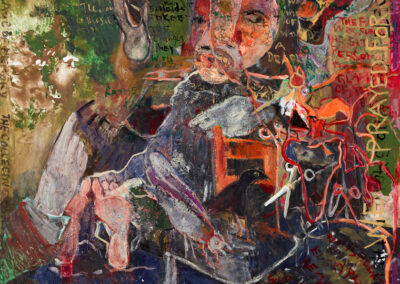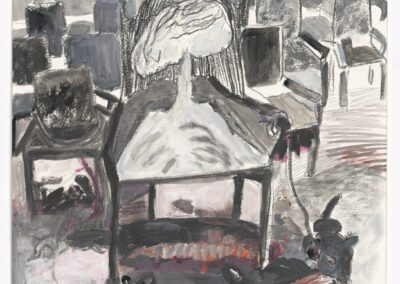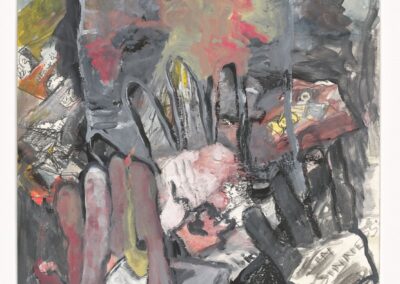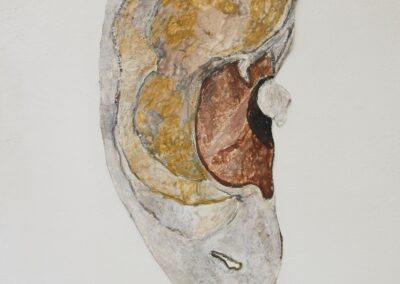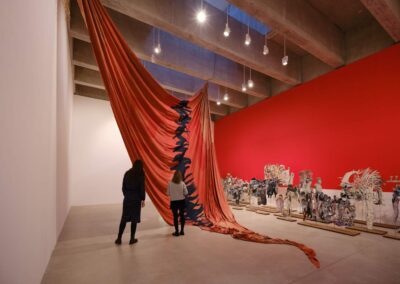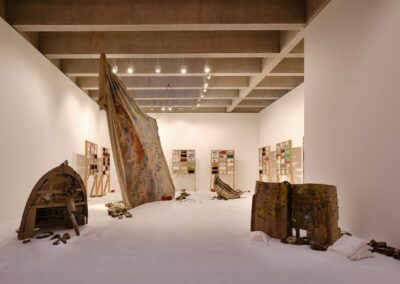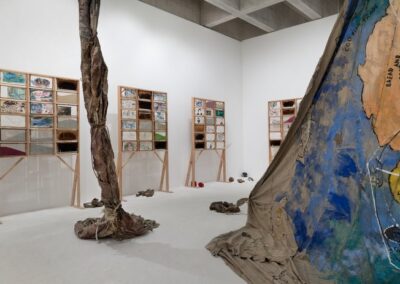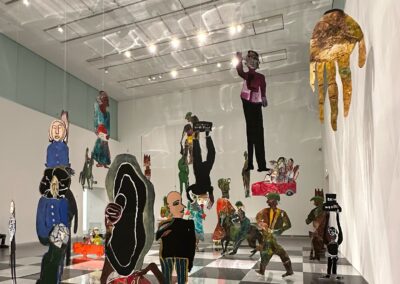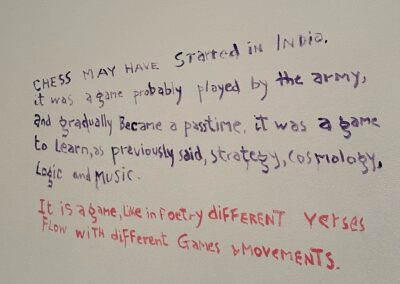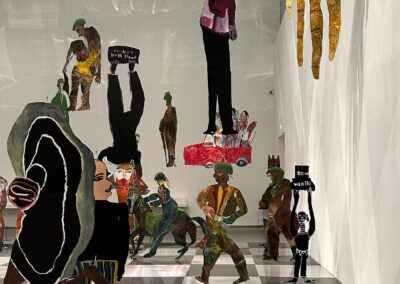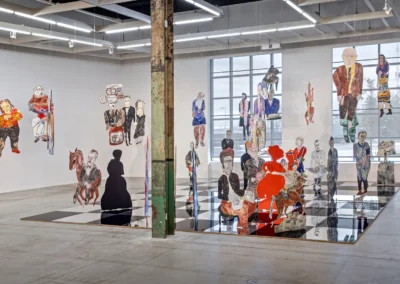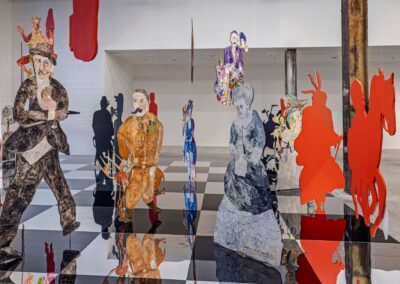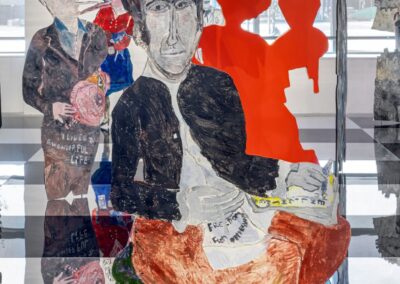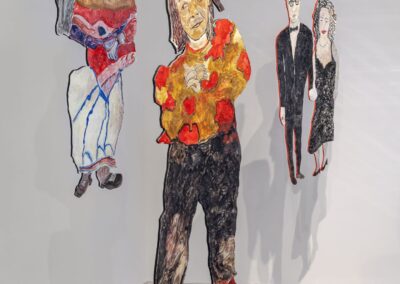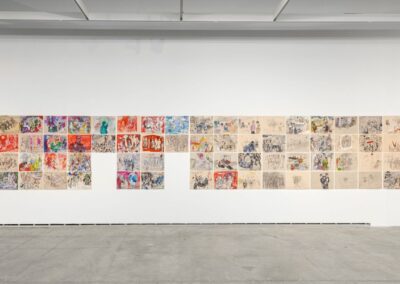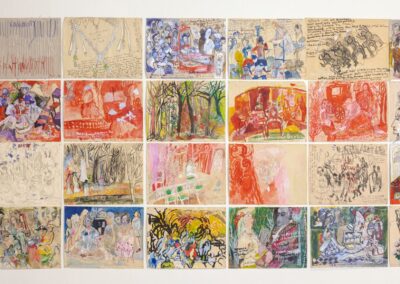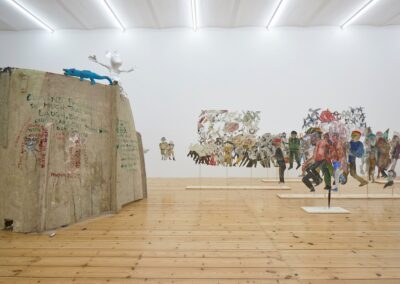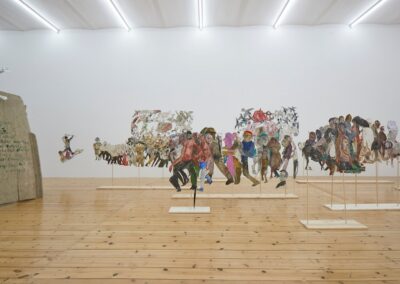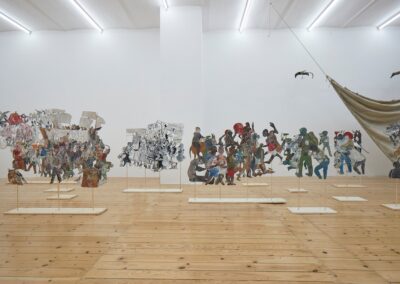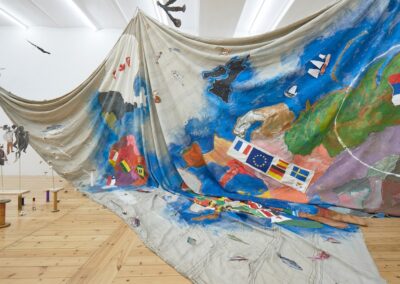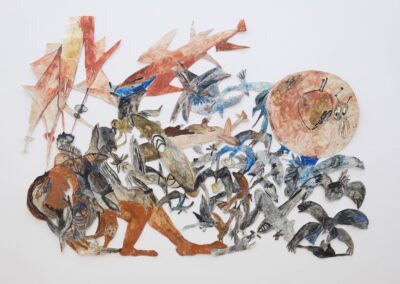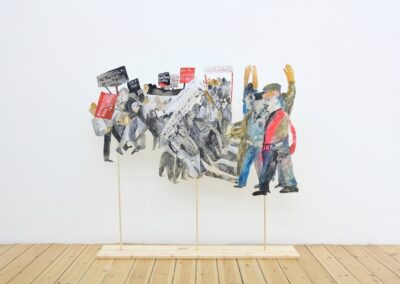Our next Artist You Need To Know is Anna Boghiguian.
Anna Boghiguian (born 1946) is widely regarded as one of Egypt’s finest and most significant contemporary artists. Her work is innately political, and is focused upon “various historical events in a political context, such as the history of the cotton trade, the salt trade and the life of Egyptian Greek poet Constantine P. Cavafy.” Boghiguian’s career began in the 1980s and her artworks are often “vast installations composed of painted figures that are arranged to fill rooms” and create environments and spaces that have been described as ‘stage sets’ that the visitor moves through and exist within, like characters from the historical narratives she mines for her artwork.
Boghiguian has “immersed herself in themes of power, trade, war, displacement, and oppression. These are global concerns, but they’re also personal: Boghiguian grew up in Cairo, the granddaughter of survivors of the Armenian genocide.” (all citations are from here)
Anna Boghiguian was born in Cairo and grew up in Heliopolis which is north of the capital. She attended the Armenian Nubarian School where one of her teachers was the Armenian painter Onnig Avedissian (1898-1974). Her further education included the American University of Cairo (1964 – 1969) where Boghiguian studied political science while also taking painting classes from the artist Fouad Kamel. She would emigrate to Canada – specifically Montreal – in the early 1970s to attend Concordia University where she studied both art and music. At this time, Boghiguian lost her ability to hear : subsequently, the ear as a metaphor has been a conceptual touchstone in her work, incorporating ideas that are metaphysical, organic, social or literal interpretations.
Returning to Egypt in 1995, Boghiguian has lived and worked in Cairo for the majority of her career while also being periodically nomadic, keeping journals and notes along the way that inform and shape her larger installations and projects.
From the Dalloul Art Foundation : “When she was twenty years old, Anna Boghiguian took to traveling the world, discovering many countries such as the United States, India, Cuba, and Nepal. She would never leave without notebooks and sketchbooks, which became the real memories of what she contemplated. Much of her art was produced in her diaries in which she combined her drawings with her poetry, texts, and collected photographs. These trips enriched herself as well as her passion for literature, and poetry: she read authors including Albert Camus (1913-1960), Fyodor Dostoyevsky (1821-1881), and Rabindranath Tagore (1861-1941). These travel adventures opened her to the world, to the cultures, and the local customs, being a source of inspiration for her artistic and written work – she is the author of some books like Anna’s Egypt, An Artist Journey, published in 2003. She depicts the cities that she visited and its people, highlighting the notion of migrations, and exile, though the motifs of the train, the river, or the desert. This gave her the reputation of a nomad artist.”
The nature of Boghiguian’s artwork means that we’ll be sharing a number of links to videos of her practice as well to offer a more comprehensive look at her work. The Dalloul Art Foundation that we cited earlier has a fine selection here. There are several other fine videos that can be enjoyed from Kunsthaus Bregenz, a longer lecture given by the artist here and Boghiguian’s artist talk for an exhibition at the Power Plant here.
The images below are from three different installations by Boghiguian. These are (as divided by row) A Play To Play (2018), The Salt Traders (2015) and Promenade dans l’inconscient (A Walk in the Unconscious), (2016). A short video tour of The Salt Traders featuring the artist can be seen here.
A significant exhibition of Boghiguian’s work was mounted at The Power Plant in Toronto. A short video made to accompany that show can be enjoyed here. The gallery below is a selection of images of that show titled Time of Change and more information about that project can be read here.
From the accompanying text to that exhibition : “Widely considered one of the most interesting contemporary artists of our time, Boghiguian is a close observer of the human condition, proposing a unique and diverse interpretation of contemporary life…she tells of how people and ideas, relationships and goods vary and evolve, sometimes bright and fluid, sometimes bound in inequality and oppression. Boghiguian’s broad insight into literature and worlds of thought makes her art a profound source of contemplation.”
Boghiguian has exhibited widely around the world. Significant solo exhibitions have taken place at SMAK, Gent (2020), Tate St. Ives (2019), the New Museum (2018) and the Museum der Moderne, Salzburg (2018). She’s been included in a number of important international group exhibitions as well. Notable ones include the 22nd Sydney Biennale (2020), Castello di Rivoli, Torino (2019), the Museum of Modern Art, New York City (2017) and the dOCUMENTA (13), Kassel (2012). In 2015 Boghiguian received the Golden Lion at the Venice Biennale (for her work in the Armenian Pavilion) and in 2023 she was awarded the Wolfgang Hahn Prize.
The images below are documentation of her installation The People’s People (2017) from when it was on view at Galerie Sfeir-Semler, Hamburg.
“My work centres around the ways in which humans are uprooted from their lands due to social, political and cultural pressures and change from outside. These people have lived on their lands for generations, connected to their unique cultures and ways. These involve religion or beliefs, languages, ways of relating to place, and myths revolving around their existence. Once a population is uprooted, so too are their languages and histories rendered irrelevant, their beliefs no longer tethered to the homes and temples in which they grew.”
Boghiguian has also illustrated several books, including a volume of poetry by the aforementioned Constantine P. Cavafy, the works of Giuseppe Ungaretti and book cover illustrations for Nobel Prize winning writer Naguib Mahfouz. As well, the American University in Cairo Press published Anna’s Egypt in 2003 : this is a collection of words and images in which Boghiguian speaks of both her experiences and memories of Egypt. A number of curators and critics have suggested that Boghiguian’s installations are like books come to life, meant to be ‘read’ as narratives in themselves, and the artist herself has spoken of the importance of literature and peoples’ stories – both in larger and more intimate historical contexts – in her work.
A larger selections of videos from the Dalloul Art Foundation (including conversations with the artist) can be enjoyed here.
Anna Boghiguian lives and works primarily in Cario, Egypt.

